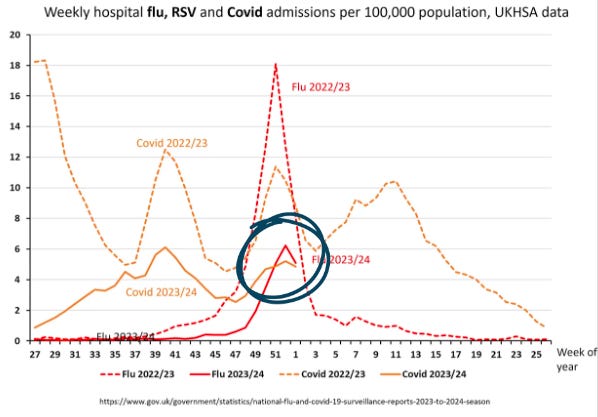Anddddd respiratory illnesses have peaked. This means we are in the smack middle of the season, as we still need to go down the wave.
Here is your state of affairs.
Influenza-like illnesses: High but declining
The number of people seeking healthcare for respiratory illnesses—fever, cough, or sore throat symptoms—is still high but declining rapidly. In previous years, we’ve seen multiple humps, so don’t be surprised if this starts increasing again.

If we look at the “big three,” flu, RSV, and Covid-19 have seen improvement. Flu is causing the most symptom burden, while Covid-19 continues to lead to severe disease.
Given that we are at the peak of the season, how is healthcare capacity? It is incredibly difficult (if not impossible) to gauge through data. This is because what happens internally (diverting care, delayed election surgeries, increased staffing for more beds, expedited discharge planning) isn’t reflected by numbers reported by hospitals. So we rely on anecdotes on the ground, like this one from Boston-based Massachusetts General Hospital a few days ago:
Almost four years after the start of the COVID-19 pandemic, Massachusetts General Hospital … continues to struggle daily with unprecedented overcrowding – particularly in its Emergency Department (ED). For the past 16 months, the MGH ED has operated nearly every day in “Code Help” or “Capacity Disaster” status.
This is concerning because it’s poorly timed with burnout and staff shortages. This will impact everyone’s care. We must figure this out if this is the “new normal.”
Now, a deeper dive into the “big three.”
Covid-19: Very high but declining
Covid-19 wastewater activity is still “very high.” In fact, it’s higher than it was last year. However, on a national level, activity is declining quickly. This basically means the newest subvariant (JN.1) is running out of new infection pathways.
There is still a lot of variability on the local level. For example, many cities—like San Jose, Chicago, and Miami—have yet to peak.

Covid-19 continues to be the leader in severe disease, like hospitalizations. Covid-19 is currently causing about 3 times more deaths than the flu.
It doesn’t have to be like this. Covid-19 vaccination rates remain abysmal (41% among those over 65 compared to 75% flu vaccine coverage). If we look at the UK, where more than 70% of the eligible population is vaccinated for Covid-19, flu hospitalizations passed those for Covid-19 this season.

Flu: High and stabilizing
Flu peaked around New Year’s and started to decline quickly. However, we typically see patterns disrupted once school starts again, which happened this year. Flu rates stabilized among kids 5-17 years old, while the other age groups continued to decline.
There have been 47 pediatric deaths due to flu so far this season.
RSV: Moderate and declining
RSV numbers remain higher than this time last year but continue to decline.
Hospitalizations among young children are nosediving. Adult RSV patterns are following pediatrics (as usual).
Other things I’m paying attention to
Spring vaccines? Many people are asking whether we will have spring Covid-19 vaccines for those over 65 again. I don’t know. But I do know that CDC’s advisory board—ACIP—has their regularly scheduled meeting at the end of February. I will keep you updated.
Measles. Beyond those discussed in the previous YLE post, another outbreak was reported in Washington state (6 measles cases linked to a family gathering). In addition, the U.K. Health Security Agency (UKHSA) declared a national incident for measles, which is a strong signal showing increased concern. Currently, 319 measles cases are linked to an outbreak in the West Midlands.
Charcuterie meats. The CDC warned of a Salmonella outbreak linked to charcuterie meats. They’re advising the public not to eat the Busseto Charcuterie Sampler from Sam’s Club or the Fratelli Beretta brand Antipasto Gran Beretta from Costco.
Bottom line
There is still a lot of sickness out there, but we are finally headed towards relief. One can’t help but wonder how this season, particularly the strain on hospitals today, would be different if more people got vaccinated.
Stay healthy out there!
Love, YLE and Andrea Tamayo
Andrea Tamayo is an intern at YLE. She is a science journalist and master’s student at the University of California, Santa Cruz Science Communication Program. You can find more of her stories at andreactamayo.com.
“Your Local Epidemiologist (YLE)” is written by Dr. Katelyn Jetelina, M.P.H. Ph.D.—an epidemiologist, wife, and mom of two little girls. During the day, she is a senior scientific consultant to several organizations, including CDC. At night, she writes this newsletter. Her main goal is to “translate” the ever-evolving public health world so that people will be well-equipped to make evidence-based decisions. This newsletter is free, thanks to the generous support of fellow YLE community members. To support this effort, subscribe below:









I’ll add to the anecdotal hospitalization reports after calling the ER on my way into work listening to this post! Here in South Jersey my health system reports ER and inpatient beds are “tight” but not critical. Improved from the last couple weeks but still “tight.”
Despite “abysmal” vaccination rates, and the missed opportunities for many people to be less sick, a spring booster seems like a good idea for those still playing the game. Dr. Daniel Griffin from TWiV unofficially endorsed as much during his weekly clinical update this week for >65yo and high risk.
I’ll take any opportunity to keep priming the well, as antigenic imprinting and other fears have not significantly materialized when compared to benefits most evident in higher risk individuals.
And if most of the additional benefit (in terms of long Covid prevention) with vaccines/boosts comes from that short lived but real 50->40->30% reduction in transmission for 3-4 months, sign me up. Each pair of dice left unrolled with Covid is good. Good for less severe disease, long Covid, and community transmission.
One can’t help but wonder how this season, particularly the strain on hospitals today, would be different if more people wore a mask/respirator. 😷